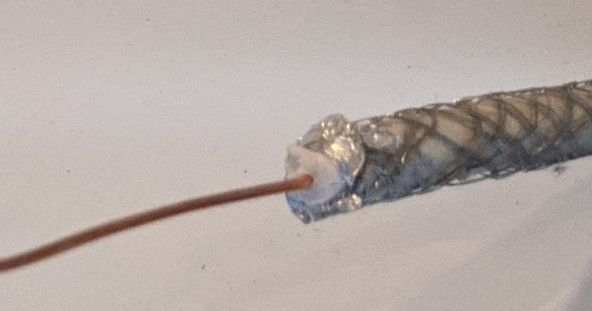DIY DVB-T/DVB-T2 indoor sleeve antenna made out of a coax antenna cable

As the DVB-T sender has been moved here within Reykjavík, I had to adjust my indoor antenna which is simply built by turning a coax-antenna cable into a half-wave dipole antenna (essentially, a variant of a sleeve antenna) : the outer insulation of the coax cable was removed so that the part with the inner wire has a lambda/4 length and the left-over shield was peeled and turned inside out over the insulation so that it also has lambda/4 length (in sum: lambda/2). The aluminum foil that was part of the shielding was removed and finally, the inner insulation removed so that the inner wire remains totally uncovered. Take care that remainders of the shield do not touch the inner wire.

For the details, including the calculations, see: http://www.vdr-wiki.de/wiki/index.php/DVB-T_Antennen (in German, but the calculations work in any language -- note that they use a correction factor of 0.95 for the length of the shield and 0.97 * lambda/4 for the length of the inner wire -- but, well, the antenna needs to cover some frequency range, so these corrections probably matter not that much).
More info on the senders in Iceland can be found at https://vodafone.is/sjonvarp/sjonvarpsthjonusta/thjonustusvaedi/ (see map at the bottom). The sender operated by Vodafone on Úlfarsfell broadcasts on three UHF channels with 8 MHz bandwidth:
- Channel 26 (514 MHz center frequency): RÚV HD (DVB-T2), RÚV 2 HD, BBC Brit, DR1, Food Network, Hringbraut, N4, National Geographic, Rás 1, Rás 2, Rondo (the latter are not TV, but radio)
- Channel 27 (522 MHz center frequency): RÚV (DVB-T only), Stöð 2, Stöð 2 Bíó, Stöð 2 Fjölskylda, Stöð 2 Sport, Stöð 2 Sport 2, Rás 1, Rás 2, Bylgjan, Fm957 , Léttbylgjan, Xið
- Channel 28 (530 MHz center frequency): Stöð 2 Golf, Stöð 2 Sport 3, Stöð 2 Sport 4, Animal Planet, Discovery.
Using 522 MHz, lambda/4 is 14.36 cm which I used for the above DIY antenna.
With the older sender where I had an unblocked line of sight, the reception was yielding almost 100% signal strength and signal quality, but with the new location of the sender on Mt. Úlfarsfell, my reception got really bad (there is a hill and high buildings in the line of sight) and signal strength is even fluctuating, which might be explained by the weather, e.g. rain can be expected to weaken the signal strength.
In addition to the above programmes, my TV receives a far stronger DVB-T signal on on channel 41 (634 MHz -- which means the calculated lambda/4 does not fit perfectly, still the received signal strength is close to 100%) which must be another sender than the one from Vodafone (it anyway broadcasts missionary programmes only).
